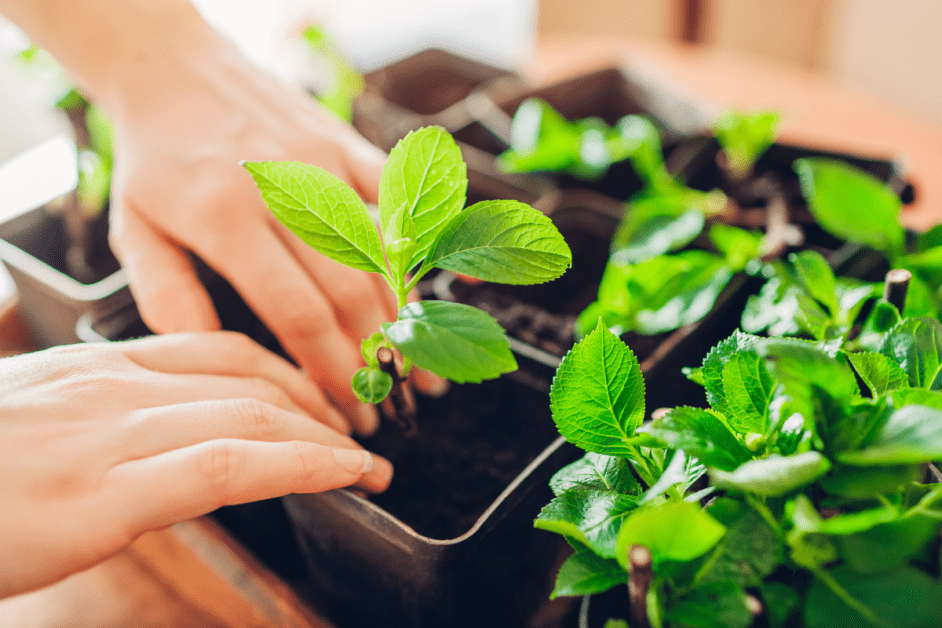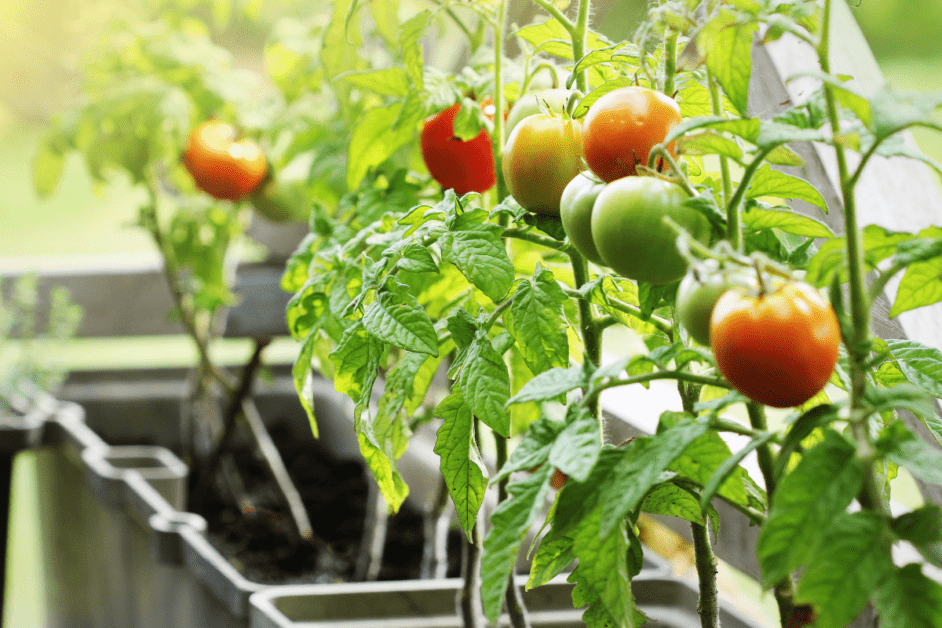Edible plants to grow in containers offer the perfect solution for you. You can enjoy fresh produce without the need for a traditional garden.
Container gardening has gained immense popularity in recent years. This is especially true if you are an urban dweller. You can still garden even if you have limited outdoor space.
You can grow your own food with the right approach. It doesn’t matter if you have a small balcony, a sunny windowsill, or a tiny backyard.
In this post, we’ll explore the best edible plants you can grow in containers. We will provide practical tips for your success. Additionally, we will highlight the benefits of this versatile gardening method.

Factors to Consider When Choosing Edible Plants to Grow in Containers
When selecting the best edible plants to grow in containers, you must consider several factors. These factors will influence your success.
Container gardening presents unique challenges and advantages, so making informed choices will help guarantee that your garden thrives.
Here is what you need to consider:
Size of the Plant
The size of the plant is crucial when choosing edible plants to grow in containers. Some plants, like dwarf varieties, are naturally more suited to smaller spaces.
Others may need larger containers to accommodate their root systems. For example, a large tomato plant will need a bigger pot than a small herb like thyme.
Root Depth Requirements
Root depth is another vital piece of information you have to put into consideration. Shallow-rooted plants like lettuce or radishes do well in smaller pots, while deep-rooted plants like carrots need more depth.
Understand the root requirements of your chosen plants. This will help you select appropriate containers. This ensures healthy growth and development of your plants.
Buy garden planters for herbs here
Buy pots for growing vegetables here
Sunlight and Watering Needs
Different edible plants to grow in containers have varying needs for sunlight and water. Some plants, like tomatoes and peppers, thrive in full sun, while others, such as lettuce, can tolerate partial shade.
Additionally, container plants typically need more frequent watering than those in the ground. Soil in containers tends to dry out faster.
It is essential that you choose plants whose sunlight and watering needs match the conditions of your growing space.
Top Edible Plants to Grow in Containers
The following selections are not only easy to manage. They also yield delicious results. This makes them perfect for you, no matter your gardening skill level.
Herbs
- Basil: This is one of the most popular herbs for container gardening. It is easy to grow and thrives in small to medium-sized pots. It prefers full sun and regular watering. Basil is versatile in the kitchen, perfect for adding fresh flavor to a variety of dishes, from pasta to salads.
- Mint: Mint is another excellent herb to grow in containers. In fact, growing it in a pot is recommended because mint can become invasive in the garden. Mint prefers partial shade and consistently moist soil. Its refreshing taste makes it ideal for teas, desserts, and garnishes.
- Thyme: This hardy herb does well in sunny spots and smaller pots. Thyme is low-maintenance and adds a savory touch to many dishes, particularly roasted meats and vegetables. It’s also a perennial, meaning it will come back year after year with proper care.
Shop for basil seeds for planting
Shop for mint seeds for planting
Shop for thyme seeds for planting
Vegetables
- Tomatoes: Tomatoes are one of the most rewarding edible plants to grow in containers. You can choose determinate (bush) varieties or cherry tomatoes, which are better suited for containers. They need large pots, full sun, and regular watering. The effort is worth it when you bite into a homegrown tomato bursting with flavor.
- Peppers: Peppers, including both sweet bell peppers and hot varieties like jalapeños, are great for container gardening. To grow these, you will need medium-sized pots, full sun, and well-drained soil. Peppers add a vibrant color and a kick of flavor to your culinary creations.
- Lettuce: Lettuce is one of the easiest edible plants to grow in containers. It is a perfect choice if you’re a beginner. It grows quickly and can be harvested continuously. Lettuce does well in shallow pots and can tolerate some shade, making it versatile for various locations.
Shop for tomato seeds for planting
Shop for bell pepper seeds for planting
Shop for lettuce seeds for planting

Fruits
- Strawberries: Strawberries are delightful edible plants to grow in containers, especially in hanging baskets or small pots. They need full sun and well-drained soil. Strawberry is relatively easy to care for. They produce sweet, juicy fruits that are a treat during the summer months.
- Dwarf Citrus Trees: dwarf varieties of citrus trees, like lemons and oranges, are excellent choices for larger containers. They need full sun and regular watering. With the right care, you can enjoy fresh citrus fruits year-round, even in limited spaces.
- Blueberries: Blueberries are perfect for container gardening, especially if you have the right soil mix (acidic soil is essential). They need a large pot, full sun, and consistent watering. Blueberries offer delicious, antioxidant-rich fruits that are great for snacking, baking, or adding to smoothies.
Shop for strawberry seeds for planting
Shop for dwarf citrus seeds for planting
Shop for blueberry seeds for planting
Root Vegetables
- Carrots: Carrots are surprisingly good edible plants to grow in containers. Ensure the container is deep enough to accommodate their long roots. You should opt for smaller or baby carrot varieties that are well-suited to container gardening. Carrots prefer full sun and consistent moisture.
- Radishes: Radishes are among the fastest-growing edible plants to grow in containers, making them ideal if you want quick results. They thrive in shallow pots, full sun, and cool weather. Radishes add a spicy crunch to your salads and other dishes.
Shop for carrot seeds for planting
Shop for radish seeds for planting
Tips for Successful Container Gardening
Growing edible plants in containers requires a bit of planning and care. Here are some tips to make sure your container garden flourishes:
Choosing the Right Container
The material and size of the container can significantly impact the success of your plants. Clay pots are breathable but can dry out quickly.
Plastic pots keep moisture better but may not provide as much air circulation. Make sure your containers have drainage holes to prevent waterlogging, which can lead to root rot.
Soil Selection and Preparation
Use high-quality potting soil designed for container gardening. Unlike garden soil, potting soil is lightweight, well-draining, and often enriched with nutrients.
Certain edible plants need a specialized soil mix to grow in containers. This is especially true for plants like blueberries. The soil mix must provide the right pH level.
Shop for potting soil for vegetables
Shop potting soil for indoor plants
Shop potting soil for citrus trees
Watering and Fertilization
Container plants generally need more frequent watering than those planted in the ground. Water deeply and consistently, ensuring that the soil is moist but not waterlogged.
Additionally, regular feeding with a balanced fertilizer will keep your plants healthy and productive. Organic options, like compost or fish emulsion, are excellent for edible plants.
Edible Plants to Grow and Managing Pests and Diseases
Pests and diseases can be a concern, even in container gardening. Keep an eye out for common issues like aphids, spider mites, and fungal infections.
Using organic pest control methods can help protect your plants. Neem oil spray or introducing beneficial insects also offer chemical-free solutions.
How to Harvest and Maintain Your Container Garden
Proper maintenance is key to enjoying a bountiful harvest from your edible plants to grow in containers.
Edible Plants to Grow and Harvesting Techniques
Knowing when and how to harvest is crucial for continuous production. For example, herbs like basil should be pinched back regularly to encourage bushy growth. Leafy greens like lettuce can be harvested leaf by leaf, allowing the plant to continue producing.
Pruning and Care
Pruning is essential for many container plants to promote healthy growth and prevent overcrowding. Regularly check for dead or yellowing leaves and trim them off to keep your plants thriving. Some plants, like tomatoes, benefit from staking or using cages to support their growth.
Edible Plants to Grow and Seasonal Considerations
Depending on your climate, you may need to adjust your container garden seasonally. In colder months, consider bringing your containers indoors or providing protection like frost covers.
Some edible plants can be overwintered with the right care. This ensures they continue to produce in the next growing season.
In conclusion, container gardening offers a flexible and rewarding way to grow your own food. You can do this no matter how much space you have.
Select the right edible plants to grow in containers. You can enjoy fresh herbs, vegetables, fruits, and even root crops right from your home.
With the tips and recommendations outlined in this guide, you’re well on your way to creating a thriving container garden. It will yield delicious and healthy produce year-round.
Happy gardening!
Additional reading:
Organic Gardening: How to Start Your Own Organic Garden
Discover more from
Subscribe to get the latest posts sent to your email.